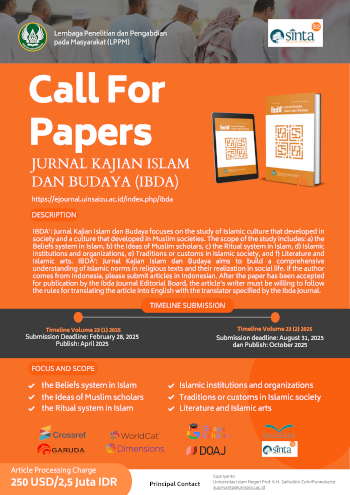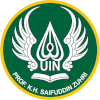The History and Values Contained in Corak Insang Weave in Pontianak Malay’s
DOI:
https://doi.org/10.24090/ibda.v16i1.1388Kata Kunci:
Value, Motive, Corak Insang WeaveAbstrak
Pontianak Malay’s society is not only limited to the Malay ethnic group who lives near the Kapuas River, but they also have a tradition that is created from the habit and Islamic learning. This paper is initiated by the study that has been conducted by the researchers in 2016 implementing qualitative descriptive method. The data collection tools consist of observation, documentation and interview. The reason for choosing this method is to discover and reveal the meaning or the ideology of the symbols contained in the corak insang weave. Based on the results of this study, it is concluded as the first conclusion that the process to make corak insang weave needs sufficient time about one week. Corak insang weave can be formed in the manufacture of other woven fabrics, through the patches weave method, songket and bundle weave. The second conclusion shows that it is unfounded that a lot of physical evidence and historical documents or from sources are related to the meanings contained in Pontianak corak insang weave motive.Unduhan
Data unduhan belum tersedia.
Referensi
Abdul Aziz, Sohaimi. 2014. Dahsyatnya Kesusasteraan Memerihalkan Kehidupan . Malaysia: Universiti Sain Malaysia.
Abu Syuqqah, Abdul Halim. 1997. Kebebasan Wanita. Jakarta: Gema Insani Press.
Darmaprawira, Sulasmi. 2002. Warna: Teori dan Kreativitas Penggunaannya. Bandung: Penerbit ITB.
DjoeraganBatik. 2013. Kolaborasi Cantik: Batik dan Tenun. Surabaya: Tiara Aksa.
Hermansyah. 2010. Ilmu Gaib di Kalimantan Barat. Jakarta: Kepustakaan Populer Gramedia.
HR, Sugeng. 2013. The Amazing of Indonesia: 71 Keajaiban Indonesian yang Wajib Diketahui. Jakarta: Anak Kita.
Margono, dkk. 2007. Apresiasi Seni: Seni Rupa dan Seni Teater 2. Yogyakarta: Ghalia Indonesia Printing.
Melalatoa, M. Junus. 1995. Ensiklopedia Suku Bangsa di Indonesia. Jilid L – Z. Jakarta: CV. Eka Putra.
Mirza, dkk. 1998. Kain Corak Insang Pontianak dalam Tradisi dan Adat Istiadat. Pontianak: Departemen Pendidikan dan Kebudayaan.
Moleong, Lexy. 2002. Metodologi Penelitian Kualitatif. Bandung: PT. Remaja Rosdakarya.
Nugroho, Sarwo. 2015. Manajemen Warna dan Desain. Yogyakarta: Andi Offset.
Nurahmartiyanti, Sufty dan Agustin Rozalena. 2010. Pernak-Pernik Pemanis Rumah. Jakarta: Penebar Swadaya.
Sudjana & Ibrahim. 2004. Penelitian dan Penilaian. Bandung: Sinar Baru Algesindo.
Sugiyono. 2007. Metode Penelitian Pendidikan Kuantitatif, Kualitatif dan R & D . Bandung: Alfabeta.
Constotutions
Peraturan Daerah Kota Pangkal Pinang Nomor 2 Tahun 2015 Tentang Pakaian Adat Pengantin serta Upacara dan Adat Perkawinan Kota Pangkal Pinang.
Internet
http://www.entrepreneurkreatif.com/2016/10/sulam-kelengkang-dan-sulam-gem-sebagai.html, 14 November 2016.
http://www.rizanmuslim.com/blog/395, 01 December 2016.
http://www.tanjungpinangpos.co.id/2014/108737/indah-menurut-pemandangan-mata-dan-hati/, 17 November 2016.
https://web.facebook.com/1659516717662181/photos/a.1659523790994807.1073741828.1659516717662181/1715597808720738/?type=3&_rdr, 15 October 2016.
Abu Syuqqah, Abdul Halim. 1997. Kebebasan Wanita. Jakarta: Gema Insani Press.
Darmaprawira, Sulasmi. 2002. Warna: Teori dan Kreativitas Penggunaannya. Bandung: Penerbit ITB.
DjoeraganBatik. 2013. Kolaborasi Cantik: Batik dan Tenun. Surabaya: Tiara Aksa.
Hermansyah. 2010. Ilmu Gaib di Kalimantan Barat. Jakarta: Kepustakaan Populer Gramedia.
HR, Sugeng. 2013. The Amazing of Indonesia: 71 Keajaiban Indonesian yang Wajib Diketahui. Jakarta: Anak Kita.
Margono, dkk. 2007. Apresiasi Seni: Seni Rupa dan Seni Teater 2. Yogyakarta: Ghalia Indonesia Printing.
Melalatoa, M. Junus. 1995. Ensiklopedia Suku Bangsa di Indonesia. Jilid L – Z. Jakarta: CV. Eka Putra.
Mirza, dkk. 1998. Kain Corak Insang Pontianak dalam Tradisi dan Adat Istiadat. Pontianak: Departemen Pendidikan dan Kebudayaan.
Moleong, Lexy. 2002. Metodologi Penelitian Kualitatif. Bandung: PT. Remaja Rosdakarya.
Nugroho, Sarwo. 2015. Manajemen Warna dan Desain. Yogyakarta: Andi Offset.
Nurahmartiyanti, Sufty dan Agustin Rozalena. 2010. Pernak-Pernik Pemanis Rumah. Jakarta: Penebar Swadaya.
Sudjana & Ibrahim. 2004. Penelitian dan Penilaian. Bandung: Sinar Baru Algesindo.
Sugiyono. 2007. Metode Penelitian Pendidikan Kuantitatif, Kualitatif dan R & D . Bandung: Alfabeta.
Constotutions
Peraturan Daerah Kota Pangkal Pinang Nomor 2 Tahun 2015 Tentang Pakaian Adat Pengantin serta Upacara dan Adat Perkawinan Kota Pangkal Pinang.
Internet
http://www.entrepreneurkreatif.com/2016/10/sulam-kelengkang-dan-sulam-gem-sebagai.html, 14 November 2016.
http://www.rizanmuslim.com/blog/395, 01 December 2016.
http://www.tanjungpinangpos.co.id/2014/108737/indah-menurut-pemandangan-mata-dan-hati/, 17 November 2016.
https://web.facebook.com/1659516717662181/photos/a.1659523790994807.1073741828.1659516717662181/1715597808720738/?type=3&_rdr, 15 October 2016.

Unduhan
Diterbitkan
2018-05-10
Cara Mengutip
Nugraha, M. T., & Kartini, K. (2018). The History and Values Contained in Corak Insang Weave in Pontianak Malay’s. IBDA` : Jurnal Kajian Islam Dan Budaya, 16(1). https://doi.org/10.24090/ibda.v16i1.1388
Terbitan
Bagian
Articles
Lisensi
Authors who publish with this journal agree to the following terms:
- Authors retain copyright and grant the journal right of first publication with the work simultaneously licensed under a Creative Commons Attribution-ShareAlike License a that allows others to share the work with an acknowledgement of the work's authorship and initial publication in this journal.
- Authors are able to enter into separate, additional contractual arrangements for the non-exclusive distribution of the journal's published version of the work (e.g., post it to an institutional repository or publish it in a book), with an acknowledgment of its initial publication in this journal.
- Authors are permitted and encouraged to post their work online (e.g., in institutional repositories or on their website) before and during the submission process, as it can lead to productive exchanges, as well as earlier and greater citation of published work (See The Effect of Open Access).















